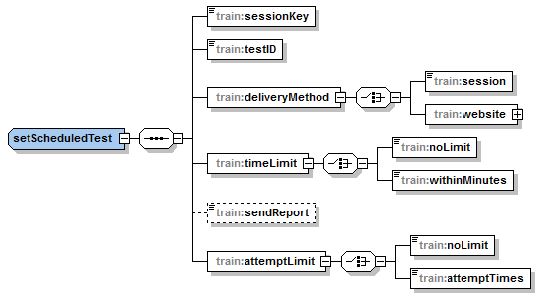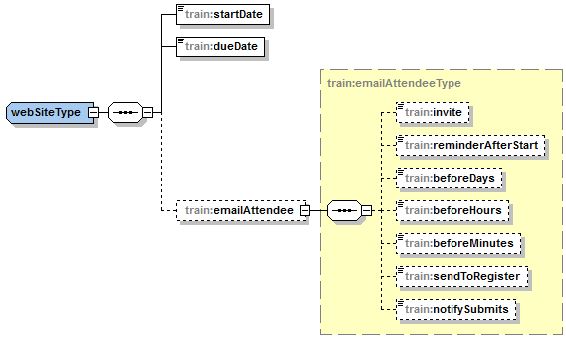SetScheduledTest
Edits the scheduling of a Training Session library test. This API only
changes the test schedule, it does not modify the actual test content.
Request
The following schema diagram shows the structure of the elements in thesetScheduledTest request message.
Figure 6-40 • Schema diagram for setScheduledTest
Figure 6-41 • Schema diagram for setScheduledTest
The sample XML document requests to change the schedule for
the test with ID 105 from Training Session 12345678.
<?xml version="1.0" encoding="UTF-8"?>
<serv:message xmlns:xsi="http://www.w3.org/2001/XMLSchema-instance">
<header>
<securityContext>
<webExID>hostid</webExID>
<password>hostpassword</password>
<siteID>0000</siteID>
<partnerID>9999</partnerID>
<email>johnsmith@xyz.com</email>
</securityContext>
</header>
<body>
<bodyContent xsi:type=
"java:com.webex.service.binding.training.SetScheduledTest">
<sessionKey>12345678</sessionKey>
<testID>105</testID>
<deliveryMethod>
<startDate>10/10/2010 00:10:00</startDate>
<dueDate>10/12/2010 00:10:00</dueDate>
</deliveryMethod>
<timeLimit>
<withinMinutes>30</withinMinutes>
</timeLimit>
<attemptLimit>
<noLimit>true</noLimit>
</attemptLimit>
</bodyContent>
</body>
</serv:message>
For descriptions of the global elements in the security context of the
header, please see Global Request Elements in Security Context.
For descriptions of the non-global elements, please refer to “Elements
in WebEx XML Schema Definitions for the Training Session Service”.
Response
The following schema diagram shows the structure of the elements in thesetScheduledTestResponse message.
Figure 6-42 • Schema diagram for setScheduledTestResponse
The sample XML document shows an example of a possible response to the
preceding request document.
<?xml version="1.0" encoding="UTF-8"?>
<serv:message xmlns:serv="http://www.webex.com/schemas/2002/06/service"
xmlns:com="http://www.webex.com/schemas/2002/06/common"
xmlns:sess="http://www.webex.com/schemas/2002/06/service/session"
xmlns:train="http://www.webex.com/schemas/2002/06/service/trainingsession"
xmlns:qti="http://www.webex.com/schemas/2002/06/service/trainingsessionqti"
xmlns:qtiasi=
"http://www.webex.com/schemas/2002/06/service/trainingsessionqtiasi">
<serv:header>
<serv:response>
<serv:result>SUCCESS</serv:result>
<serv:gsbStatus>PRIMARY</serv:gsbStatus>
</serv:response>
</serv:header>
<serv:body>
<serv:bodyContent xsi:type="train:SetScheduledTestResponse"
xmlns:xsi="http://www.w3.org/2001/XMLSchema-instance" />
</serv:body>
</serv:message>
The result and exceptionID global elements allow you to confirm that
an instantiation request was successful. They are described in "Global Response
Elements Showing Results and Errors”.


